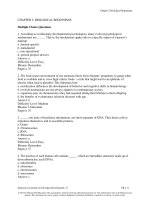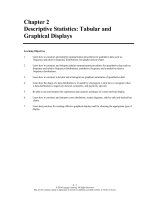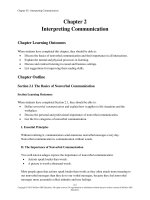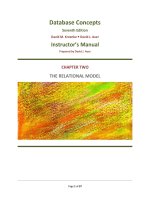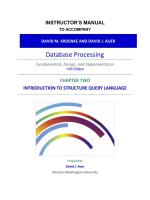Test bank and solution manual of database concept 7e (2)
Bạn đang xem bản rút gọn của tài liệu. Xem và tải ngay bản đầy đủ của tài liệu tại đây (1.87 MB, 37 trang )
Database Concepts
Seventh Edition
David M. Kroenke • David J. Auer
Instructor’s Manual
Prepared by David J. Auer
CHAPTER TWO
THE RELATIONAL MODEL
Page 1 of 37
Instructor’s Manual to accompany:
Database Concepts (Seventh Edition)
David M. Kroenke and David J. Auer
© 2015, 2013, 2011, 2010, 2008 Pearson Education, Inc. Publishing as Prentice Hall
Page 2 of 37
Chapter Two – The Relational Model
CHAPTER OBJECTIVES
Learn the conceptual foundation of the relational model
Understand how relations differ from nonrelational tables
Learn basic relational terminology
Learn the meaning and importance of keys, foreign keys, and related terminology
Understand how foreign keys represent relationships
Learn the purpose and use of surrogate keys
Learn the meaning of functional dependencies
Learn to apply a process for normalizing relations
CHAPTER ERRATA
There are no known errors at this time. Any errors that are discovered in the future will
be reported and corrected in the Online DBC e07 Errata document, which will be
available at />
THE ACCESS WORKBENCH
Solutions to the Access Workbench exercises may be found in Solutions to all Sections:
The Access Workbench, which is a separate document within the Instructor’s Manual.
TEACHING SUGGESTIONS
The Art Course database discussed in Chapter 1 is a good database to use for an inclass demo of the concepts in this chapter. The DBMS screenshots in Chapter 2 use
that database as the example database. See the list, data and database files
supplied, and use the following:
Microsoft Access 2013:
“Art Course List” in DBC-e07-Lists-And-Data.xlsx
DBC-e07-Art-Course-Database-CH01.accdb
Microsoft SQL Server 2014 Express Edition:
DBC-e07-MSSQL-Art-Course-Database-Create-Tables.sql
DBC-e07-MSSQL-Art-Course-Database-Insert-Data.sql
NOTE: Create a database diagram for the database
Page 3 of 37
Chapter Two – The Relational Model
Oracle Database Express Edition 11g Release 2:
DBC-e07-ODB-Art-Course-Database-Create-Tables.sql
DBC-e07-ODB-Art-Course-Database-Insert-Data.sql
DBC-e07-ODB-Art-Course-Database-SQL-Queries-CH01.sql
MySQL 5.6:
DBC-e07-MySQL-Art-Course-Database-Create-Tables.sql
DBC-e07-MySQL-Art-Course-Database-Insert-Data.sql
The goal of this chapter is to present an overview of the major elements of the
relational model. This includes the definition of a relation, important terminology, the
use of surrogate keys, and basic design principles.
Students often misconstrue the statement that only a single element is allowed in a
cell to mean that the cells must be fixed in length. One can have a variable length
memo in a cell but that is considered, semantically, to be one thing. By the way,
there are a number of reasons for this restriction. Perhaps the easiest to explain is
that SQL has no means for addressing sub-elements in a cell.
When students execute SQL SELECTs, they may generate relations with duplicate
rows. Such results do not fit the definition of relations, but they are considered
relations nonetheless. This is a good example of “theory versus practice”.
You may want to emphasize that foreign keys and the primary key that they
reference need not have the same name. They must, however, have the same
underlying set of values (domain). This means that the values not just look the
same; it means that the values mean the same thing. A foreign key of CatName and
a foreign key of ValentineNickName might look the same, but they do not mean the
same thing. Using ValentineNickName as a foreign key to Name in the relation CAT
would result in some weird results.
Referential integrity constraints are important. You might ask the students to think of
an example when a foreign key does not have a referential integrity constraint
(answer: whenever a parent row is optional, say, STUDENTs need not have an
ADVISER).
We favor the use of surrogate keys. Unless there is a natural, numeric ID (like
PartNumber), we almost always add a surrogate key to our database designs.
Sometimes a surrogate key will be added even if there is a natural, numeric ID for
consistency. Surrogate keys can cause problems (primarily patching up foreign
keys) if the database imports data from other databases that either do not employ a
surrogate key or use a different one. In some cases, institutions have developed
policies for ensuring that surrogate keys are unique globally. It’s probably best for
the students to get into the habit of using them and consider not using them as an
exception. Professional opinions vary on this, however.
Page 4 of 37
Chapter Two – The Relational Model
If you’re using Oracle Database, then you’ll need to teach the use of sequences to
implement surrogate keys. Sequences are an awkward solution to this problem,
however, and may be why surrogate keys are less used in the Oracle-world. Maybe
there will be a better solution to them from Oracle in the future.
The discussion of functional dependencies is critical—maybe the most important in
the book. If students can understand that all tables do is record “data points” of
functional dependencies, then normalization will be easier and seem more natural.
In physics, because there are formulae like F = ma, we need not store tables and
tables of data recording data points for force, mass, and acceleration. The formula
suffices for all data points. However, there is no formula for computing how much a
customer of, say, American Airlines, owes for his or her ticket from New York to
Houston. If we could say the cost of an airline ticket was $.05 per mile, then we
could compute the cost of a ticket, and tables of airline flight prices would be
unnecessary. But, we cannot; it all depends on … So, we store the data points for
functional dependencies in tables.
If we use domain/key normal form as the ultimate, then, insofar as functional
dependencies are concerned, the domain/key definition that “every constraint is a
logical consequence of domains and keys,” comes down to Boyce-Codd Normal
Form. Therefore, we proceed on good theoretical ground with the discussion as
presented in this chapter.
Students should understand three ambiguities in a null value. This understanding
will help them comprehend the issues addressed by INNER and OUTER joins in the
next chapter.
Exercises 2.40 and 2.41 deal with multivalued dependencies and fourth normal form
(4NF). These are instructive as they show students how to deal with situations
where the value of one column in a table is associated with several values of another
attribute in (at least initially) the same table. This is an important concept, and after
BCNF it is the next important concept students need to understand about
normalization.
Page 5 of 37
Chapter Two – The Relational Model
ANSWERS TO REVIEW QUESTIONS
2.1
Why is the relational model important?
It is the single most important standard in database processing and is used for the design and
implementation of almost every commercial database worldwide.
2.2
Define the term entity and give an example of an entity (other than the one from this
chapter).
Entity is the formal name for a “thing” that is being tracked in a database, and is defined as
something of importance to the user that needs to be represented in the database.
Example: TEXTBOOK
2.3
2.4
List the characteristics a table must have to be considered a relation.
Rows contain data about an entity.
Columns contain data about attributes of the entity
Cells of the table hold a single value.
All entries in a column are of the same kind.
Each column has a unique name.
The order of the columns is unimportant.
The order of the rows is unimportant.
Give an example of a relation (other than one from this chapter).
Example: TEXTBOOK (ISBN, Title, Publisher, Copyright)
2.5
Give an example of a table that is not a relation (other than one from this chapter).
Example: TEXTBOOK (ISBN, Title, Publisher, Copyright, Authors)
A table is not a relation when there are multiple author names in the Authors column.
2.6
Under what circumstances can an attribute of a relation be of variable length?
It can be of a variable length, if that attribute is considered to be a single thing like a memo or
other variable length data item.
2.7
Explain the use of the terms file, record, and field.
These terms are synonyms for table, row, and column. These terms, however, generally refer to
pre-relational bases.
Page 6 of 37
Chapter Two – The Relational Model
2.8
Explain the use of the terms relation, tuple, and attribute.
These terms are synonyms for table, row, and column. These terms, however, are the ones
used in relational database theory.
2.9
Under what circumstances can a relation have duplicate rows?
When manipulating a relation with a DBMS we may end up with duplicate rows. Although in
theory we should eliminate the duplicates, in practice this is often not done.
2.10
Define the term unique key and give an example.
A unique key is a column whose values identify one and only one row.
Example: TEXTBOOK (ISBN, Title, Publisher, Copyright)
where ISBN is a unique identifier.
2.11
Define the term nonunique key and give an example.
A nonunique key not only identifies a row, but it potentially identifies more than one row.
EXAMPLE: TEXTBOOK (ISBN, Title, Publisher, Copyright)
Publisher is a nonunique identifier.
2.12
Give an example of a relation with a unique composite key.
EXAMPLE: APARTMENT (BuildingNumber, ApartmentNumber, NumberOfBedrooms, Rent)
where (BuildingNumber, ApartmentNumber) is a unique composite key.
2.13
Explain the difference between a primary key and a candidate key.
Both are unique identifiers. One is chosen to be the identifier for the relation and for foreign
keys based on the relation. The other could be chosen as well, but since it is not, it is called a
candidate.
2.14
Describe four uses of a primary key.
A primary key can be used
to identify a row.
to represent the row in foreign keys.
to organize storage for the relation.
as a basis for indexes and other structures to facilitate searching in storage.
Page 7 of 37
Chapter Two – The Relational Model
2.15
What is a surrogate key, and under what circumstances would you use one?
A surrogate key is a unique, numeric identifier that is appended to a relation to serve as the
primary key.
2.16
How do surrogate keys obtain their values?
They are supplied automatically by the DBMS.
2.17
Why are the values of surrogate keys normally hidden from users on forms, queries, and
reports?
Surrogate keys are normally hidden because they usually have no meaning to the users.
2.18
Explain the term foreign key and give an example.
A foreign key creates the relationship between the tables; its key value corresponds to a primary
key in a relation other than the one where the key is a primary key.
EXAMPLE:
TEXTBOOK (ISBN, Title, Publisher, Copyright)
PUBLISHER (PublisherName, Street, City, State, Zip)
Publisher in TEXTBOOK is a foreign key that references PublisherName in PUBLISHER.
2.19
Explain how primary keys and foreign keys are denoted in this book.
Primary keys are underlined and foreign keys are in italics.
2.20
Define the term referential integrity constraint and give an example of one.
Referential integrity constraint is a rule specifying that every value of a foreign key matches a
value of the primary key.
Example: Publisher in TEXTBOOK must exist in PublisherName in PUBLISHER.
2.21
Explain three possible interpretations of a null value.
Three possible interpretations are:
Value not appropriate
Value known to be blank
Value appropriate and unknown
Page 8 of 37
Chapter Two – The Relational Model
2.22
Give an example of a null value (other than one from this chapter), and explain each of
the three possible interpretations for that value.
An example of null value would be: Null value for the attribute DeceasedDate in the table
SUBSCRIBER.
2.23
The subscriber may be a corporation and a value is inappropriate.
The subscriber may be alive, and the value is known to be blank.
The subscriber may be dead, but the date of death is unknown, and the value is
appropriate, but not none.
Define the terms functional dependency and determinant, using an example not from
this book.
A functional dependency is a logical relationship in which the value of one item in the
relationship can be determined by knowing the value of the other item.
EXAMPLE: ISBN Title
This means that if the ISBN (of a textbook) is known, then we will also know (can determine) the
title. The item on the left—the one whose value is known—is called the determinant.
2.24
In the following equation, name the functional dependency and identify the
determinant(s):
Area = Length Width
The functional dependency is:
(Length, Width) Area
(Length, Width) is the determinant.
Note this is different than saying “Length and Width are the determinants”.
2.25
Explain the meaning of the following expression:
A (B, C)
Given this expression, tell if it is also true that:
AB
and
AC
Page 9 of 37
Chapter Two – The Relational Model
The functional dependency:
A (B, C)
means that a value of A determines the value of both B and C.
Yes, it is true that
A B and A C
2.26
Explain the meaning of the following expression:
(D, E) F
Given this expression, tell if it is also true that:
DF
and
EF
The functional dependency:
(D, E) F
means that values of the pair (D, E) determine the value of F.
No, it is not true that
D F and E F
2.27
Explain the differences in your answers to questions 2.25 and 2.26.
A (B, C) is just shorthand for A B and A C
However, (D, E) F means that the composite, as a whole, identifies F.
For example:
EmployeeNumber (FirstName, LastName)
This means that
EmployeeNumber FirstName
and that
EmployeeNumber LastName.
But:
(FirstName, LastName) HireDate
does not mean that FirstName HireDate (There could be lots of employees named “Bob”.)
Page 10 of 37
Chapter Two – The Relational Model
2.28
Define the term primary key in terms of functional dependencies.
A primary key is one or more attributes that functionally determines all of the other attributes.
2.29
If you assume that a relation has no duplicate data, how do you know there is always at
least one primary key?
Because the collection of all the attributes in the relation can identify a unique row.
2.30
How does your answer to question 2.29 change if you allow a relation to have duplicate
data?
It doesn’t work—such tables do not have a primary key.
2.31
In your own words, describe the nature and purpose of the normalization process.
The purpose of the normalization process is to prevent update problems in the tables (relations)
in the database. The nature of the normalization process is that we break up relations as
necessary to ensure that every determinant is a candidate key.
2.32
Examine the data in the Veterinary Office List—Version One in Figure 1-30 (see page
52), and state assumptions about functional dependencies in that table. What is the
danger of making such conclusions on the basis of sample data?
PetName (PetType, PetBreed, PetDOB, OwnerLastName, OwnerFirstName,
OwnerPhone, OwnerEmail)
OwnerEmail (OwnerLastName, OwnerFirstName, OwnerPhone)
OwnerPhone (OwnerLastName, OwnerFirstName, OwnerEmail)
The danger is that there may be possibilities not apparent from sample data. For example, two
owners might have pets with the same name.
2.33
Using the assumptions you stated in your answer to question 2.32, what are the
determinants of this relation? What attribute(s) can be the primary key of this relation?
Attributes that can be the primary key are called candidate keys.
2.34
Determinants:
PetName, OwnerEmail, OwnerPhone
Candidate keys:
PetName
Describe a modification problem that occurs when changing data in the relation in
question 2.32 and a second modification problem that occurs when deleting data in this
relation.
Changes to owner data may need to be made in several rows.
Deleting data for the last pet of an owner deletes owner data as well.
Page 11 of 37
Chapter Two – The Relational Model
2.35
Examine the data in the Veterinary Office List—Version Two in Figure 1-31 (see page
55), and state assumptions about functional dependencies in that table.
PetName (PetType, PetBreed, PetDOB, OwnerLastName, OwnerFirstName,
OwnerPhone, OwnerEmail)
OwnerEmail (OwnerLastName, OwnerFirstName, OwnerPhone)
OwnerPhone (OwnerLastName, OwnerFirstName, OwnerEmail)
(PetName, Date) (Service, Charge)
The last functional dependency assumes a pet is seen at most on one day and that there is no
standard charge for a service.
2.36
2.37
Using the assumptions you stated in your answer to question 2.35, what are the
determinants of this relation? What attribute(s) can be the primary key of this relation?
Determinants:
PetName, OwnerEmail, OwnerPhone, (PetName, Date)
Candidate keys:
(PetName, Date)
Explain a modification problem that occurs when changing data in the relation in
question 2.35 and a second modification problem that occurs when deleting data in this
relation.
Same as 2.34:
Changes to owner data may need to be made in several rows.
Deleting data for the last pet of an owner deletes owner data as well.
2.38
ANSWERS TO EXERCISES
Apply the normalization process to the Veterinary Office List—Version One relation
shown in Figure 1-30 (see page 55) to develop a set of normalized relations. Show the
results of each of the steps in the normalization process.
STEP ONE:
PET-AND-OWNER (PetName, PetType, PetBreed, PetDOB, OwnerLastName, OwnerFirstName,
OwnerPhone, OwnerEmail)
Functional Dependencies:
PetName (PetType, PetBreed, PetDOB, OwnerLastName, OwnerFirstName,
OwnerPhone, OwnerEmail)
OwnerEmail (OwnerLastName, OwnerFirstName, OwnerPhone)
OwnerPhone (OwnerLastName, OwnerFirstName, OwnerEmail)
PET-AND-OWNER Candidate Keys:
PetName
Page 12 of 37
Chapter Two – The Relational Model
Is every determinant a candidate key?
NO—OwnerEmail and OwnerPhone are NOT candidate keys.
STEP TWO:
Break into two relations: OWNER and PET
OWNER (OwnerLastName, OwnerFirstName, OwnerPhone, OwnerEmail)
PET (PetName, PetType, PetBreed, PetDOB, {Foreign Key})
FOR OWNER:
Functional Dependencies:
OwnerEmail (OwnerLastName, OwnerFirstName, OwnerPhone)
OwnerPhone (OwnerLastName, OwnerFirstName, OwnerEmail)
OWNER Candidate Keys:
OwnerPhone, OwnerEmail
Is every determinant a candidate key?
YES—OwnerEmail and OwnerPhone are candidate keys—Normalization complete!
We can choose either candidate key as primary key.
(A)
IF WE USE OwnerPhone as primary key, THEN:
OWNER (OwnerPhone, OwnerLastName, OwnerFirstName, OwnerEmail)
PET (PetName, PetType, PetBreed, PetDOB, OwnerPhone)
Functional Dependencies:
PetName (PetType, PetBreed, PetDOB, OwnerPhone)
PET Candidate Keys:
PetName
Is every determinant a candidate key?
YES—PetName is a candidate key—Normalization complete!
FINAL NORMALIZED REALTIONS:
OWNER (OwnerPhone, OwnerLastName, OwnerFirstName, OwnerEmail)
PET (PetName, PetType, PetBreed, PetDOB, OwnerPhone)
(B)
IF WE USE OwnerEmail as primary key, THEN:
OWNER (OwnerPhone, OwnerLastName, OwnerFirstName, OwnerEmail)
PET (PetName, PetType, PetBreed, PetDOB, OwnerEmail)
Functional Dependencies:
PetName (PetType, PetBreed, PetDOB, OwnerEmail)
PET Candidate Keys:
PetName
Page 13 of 37
Chapter Two – The Relational Model
Is every determinant a candidate key?
YES—PetName is a candidate key—Normalization complete!
FINAL NORMALIZED REALTIONS:
OWNER (OwnerPhone, OwnerLastName, OwnerFirstName, OwnerEmail)
PET (PetName, PetType, PetBreed, PetDOB, OwnerEmail)
2.39
Apply the normalization process to the Veterinary Office List—Version Two relation
shown in Figure 1-31 (see page 56) to develop a set of normalized relations. Show the
results of each of the steps in the normalization process.
STEP ONE:
PET-AND-OWNER (PetName, PetType, PetBreed, PetDOB, OwnerLastName,
OwnerFirstName, OwnerPhone, OwnerEmail, Service, Date, Charge)
Functional Dependencies:
PetName (PetType, PetBreed, PetDOB, OwnerLastName, OwnerFirstName,
OwnerPhone, OwnerEmail)
OwnerEmail (OwnerLastName, OwnerFirstName, OwnerPhone)
OwnerPhone (OwnerLastName, OwnerFirstName, OwnerEmail)
(PetName, Date) (Service, Charge)
The last functional dependency assumes a pet is seen at most on one day and that there is no
standard charge for a service.
PET-AND-OWNER Candidate Keys:
(PetName, Date)
Is every determinant a candidate key?
NO—PetName, OwnerEmail and OwnerPhone are NOT candidate keys.
STEP TWO:
Break into two relations:
OWNER and PET-SERVICE
OWNER (OwnerLastName, OwnerFirstName, OwnerPhone, OwnerEmail)
PET-SERVICE (PetName, PetType, PetBreed, PetDOB, {Foreign Key}, Service, Date, Charge)
FOR OWNER:
Functional Dependencies:
OwnerEmail (OwnerLastName, OwnerFirstName, OwnerPhone)
OwnerPhone (OwnerLastName, OwnerFirstName, OwnerEmail)
OWNER Candidate Keys:
OwnerPhone, OwnerEmail
Page 14 of 37
Chapter Two – The Relational Model
Is every determinant a candidate key?
YES—OwnerEmail and OwnerPhone are candidate keys—Normalization complete!
We can choose either candidate key as primary key. We will use OwnerPhone.
If a student chooses OwnerEmail, the steps will be similar as shown in Exercise 2.37.
IF WE USE OwnerPhone as primary key, THEN:
OWNER (OwnerPhone, OwnerLastName, OwnerFirstName, OwnerEmail)
PET-SERVICE (PetName, PetType, PetBreed, PetDOB, OwnerPhone, Service, Date, Charge)
FOR PET-SERVICE:
Functional Dependencies:
PetName (PetType, PetBreed, PetDOB, OwnerPhone)
(PetName, Date) (Service, Charge)
The last functional dependency assumes a pet is seen at most on one day and that there is no
standard charge for a service.
PET-AND-SERVICE Candidate Keys:
(PetName, Date)
Is every determinant a candidate key?
NO—PetName is NOT a candidate key.
STEP THREE:
Break PET-SERVICE into two relations:
PET and SERVICE
OWNER (OwnerPhone, OwnerLastName, OwnerFirstName, OwnerEmail)
PET (PetName, PetType, PetBreed, PetDOB, OwnerPhone)
SERVICE (PetName, Date, Service, Charge)
PET Functional Dependencies:
PetName (PetType, PetBreed, PetDOB, OwnerPhone)
PET Candidate Keys:
PetName
Is every determinant a candidate key?
YES—PetName is a candidate key—Normalization complete!
SERVICE Functional Dependencies:
(PetName, Date) (Service, Charge)
The functional dependency assumes a pet is seen at most on one day and that there is no
standard charge for a service.
SERVICE Candidate Keys:
(PetName, Date)
Page 15 of 37
Chapter Two – The Relational Model
Is every determinant a candidate key?
YES—(PetName, Date) is a candidate key—Normalization complete!
FINAL NORMALIZED REALTIONS:
OWNER (OwnerPhone, OwnerLastName, OwnerFirstName, OwnerEmail)
PET (PetName, PetType, PetBreed, PetDOB, OwnerPhone)
SERVICE (PetName, Date, Service, Charge)
2.40
Consider the following relation:
STUDENT (StudentNumber, StudentName, SiblingName, Major)
Assume that the values of SiblingName are the names of all of a given student’s brothers
and sisters; also assume that students have at most one major.
A.
B.
Show an example of this relation for two students, one of whom has three
siblings and the other of whom has only two siblings.
StudentNumber
StudentName
SiblingName
Major
100
Mary Jones
Victoria
Accounting
100
Mary Jones
Slim
Accounting
100
Mary Jones
Reginald
Accounting
200
Fred Willows
Rex
Finance
200
Fred Willows
Billy
Finance
List the candidate keys in this relation.
STUDENT Candidate Keys:
(StudentNumber, SiblingName)
This assumes that StudentName is not unique.
C.
State the functional dependencies in this relation.
StudentNumber (StudentName, Major)
(StudentNumber, SiblingName) (StudentName, Major)
D.
Explain why this relation does not meet the relational design criteria set out in
this chapter (i.e., why this is not a well-formed relation).
Some attributes are functionally dependent on a part of the composite primary key.
Page 16 of 37
Chapter Two – The Relational Model
E.
Divide this relation into a set of relations that meet the relational design criteria
(that is, that are well formed).
Break into two relations:
STUDENT and STUDENT-SIBLING
STUDENT (StudentNumber, StudentName, Major)
STUDENT-SIBLING (StudentNumber, SiblingName)
FOR STUDENT-SIBLING:
Functional Dependencies:
(StudentNumber, SiblingName) (StudentNumber)
(StudentNumber, SiblingName) (SiblingName)
STUDENT-SIBLING Candidate Keys:
(StudentNumber, SiblingName)
Is every determinant a candidate key?
YES—(StudentNum, SiblingName) is a candidate key—Normalization complete!
FOR STUDENT:
STUDENT (StudentNumber, StudentName, Major)
Functional Dependencies:
StudentNumber (StudentName, Major)
STUDENT Candidate Keys:
StudentNumber
Is every determinant a candidate key?
YES—StudentNumber is a candidate key—Normalization complete!
FINAL NORMALIZED REALTIONs:
STUDENT (StudentNumber, StudentName, Major)
STUDENT-SIBLING (StudentNumber, SiblingName)
2.41
Alter question 2.40 to allow students to have multiple majors. In this case, the relational
structure is:
STUDENT (StudentNumber, StudentName, SiblingName, Major)
A.
Show an example of this relation for two students, one of whom has three
siblings and the other of whom has one sibling. Assume that each student has a
single major.
Page 17 of 37
Chapter Two – The Relational Model
StudentNumber
StudentName
SiblingName
Major
100
Mary Jones
Victoria
Accounting
100
Mary Jones
Slim
Accounting
100
Mary Jones
Reginald
Accounting
200
Fred Willows
Rex
Finance
B.
Show the data changes necessary to add a second major for only the first
student.
StudentNumber
StudentName
SiblingName
Major
100
Mary Jones
Victoria
Accounting
100
Mary Jones
Slim
Accounting
100
Mary Jones
Reginald
Accounting
200
Fred Willows
Rex
Finance
100
Mary Jones
Victoria
InfoSystems
100
Mary Jones
Slim
InfoSystems
100
Mary Jones
Reginald
InfoSystems
C.
Based on your answer to part B, show the data changes necessary to add a
second major for the second student.
StudentNumber
StudentName
SiblingName
Major
100
Mary Jones
Victoria
Accounting
100
Mary Jones
Slim
Accounting
100
Mary Jones
Reginald
Accounting
200
Fred Willows
Rex
Finance
100
Mary Jones
Victoria
InfoSystems
100
Mary Jones
Slim
InfoSystems
100
Mary Jones
Reginald
InfoSystems
200
Fred Willows
Rex
Accounting
Page 18 of 37
Chapter Two – The Relational Model
D.
Explain the differences in your answers to parts B and C. Comment on the
desirability of this situation.
We had to add three rows in the first case—one major for each of the siblings of the
student. If we didn’t do that, it would appear the student has a sibling with one major,
but doesn’t have the sibling as a second major. This is nuts!
E.
Divide this relation into a set of well-formed relations.
If we split STUDENT into two relations, STUDENT and STUDENT-SIBLING, then we get:
STUDENT (StudentNumber, StudentName, Major)
STUDENT-SIBLING (StudentNumber, SiblingName)
The relation is identical to the STUDENT-SIBS relation in 2.38 above, and is properly
normalized. Now we need to check STUDENT-MAJOR.
FOR STUDENT:
STUDENT (StudentNumber, StudentName, Major)
Functional Dependencies:
StudentNumber (StudentName)
(StudentNumber, Major) StudentName
STUDENT Candidate Keys:
(StudentNumber, Major)
Is every determinant a candidate key?
NO—StudentNumber is NOT a candidate key.
Break into two relations:
STUDENT-2 and STUDENT-MAJOR
STUDENT-2 (StudentNumber, StudentName)
STUDENT-MAJOR (StudentNumber, Major)
FOR STUDENT-2:
Functional Dependencies:
StudentNumber StudentName
STUDENT_2 Candidate Keys:
StudentNumber
Is every determinant a candidate key?
YES—StudentNumber is a candidate key—Normalization complete!
Page 19 of 37
Chapter Two – The Relational Model
FOR STUDENT-MAJOR:
Functional Dependencies:
(StudentNumber, Major) StudentNumber
(StudentNumber, Major) Major
STUDENT_2 Candidate Keys:
(StudentNumber, Major)
Is every determinant a candidate key?
YES—(StudentNumber, Major) is a candidate key—Normalization complete!
FINAL NORMALIZED REALTIONs:
STUDENT-2 (StudentNumber, StudentName)
STUDENT-MAJOR (StudentNumber, Major)
STUDENT-SIBLING (StudentNumber, SiblingName)
2.42
The text states that you can argue that “the only reason for having relations is to store
instances of functional dependencies.” Explain, in your own words, what this means.
In a properly normalized relation, each row of the relation consists of a primary key value (which
is a determinant) and attribute values (which are all functionally dependent on the primary key).
Thus, properly normalized relations store instances of functional dependencies, and only
instances of functional dependencies. So we can say that the purpose of relations is to store
instances of functional dependencies.
2.43
Consider a table named ORDER_ITEM, with data as shown in Figure 2-26. The schema
for ORDER_ITEM is:
ORDER_ITEM (OrderNumber, SKU, Quantity, Price)
Where SKU is a “Stocking Keeping Unit” number, which is similar to a part number. Here
it indicates which product was sold on each line of the table. Note that one OrderNumber
must have at least one SKU associated with it, and may have several. Use this table and
the detailed discussion of normal forms of pages 88-89 to answer the following
questions.
A. Define 1NF. Is ORDER_ITEM in 1NF? If not, why not, and what would have to
be done to put it into 1NF? Make any changes necessary to put ORDER_ITEM
into 1NF. If this step requires you to create an additional table, make sure that the
new table is also in 1NF.
Page 20 of 37
Chapter Two – The Relational Model
First Normal Form is any table that meets the definition of a relation (Figure 2.1 below).
ORDER_ITEM is in 1NF.
B. Define 2NF. Now that ORDER_ITEM is in 1NF, is it also in 2NF? If not, why
not, and what would have to be done to put it into 2NF? Make any changes
necessary to put ORDER_ITEM into 2NF. If this step requires you to create an
additional table, make sure that the new table is also in 2NF.
Second Normal Form is any table that 1) in First Normal Form, and 2) all nonkey
attributes are determined by the entire primary key. In this case, the Primary Key is
OrderNumber, SKU. Because SKU alone determines Price (SKU → Price), ORDER_ITEM is
NOT in 2NF.
This is solved by creating another table (PRODUCT), where SKU is both the Primary Key
and Foreign Key in PRODUCT, and Price is moved out of ORDER_ITEM and into the
PRODUCT Table.
ORDER_ITEM (OrderNumber, SKU, Quantity)
PRODUCT (SKU, Price)
C. Define 3NF. Now that ORDER_ITEM is in 2NF, is it also in 3NF? If not, why
not, and what would have to be done to put it into 3NF? Make any changes
necessary to put ORDER_ITEM into 3NF. If this step requires you to create an
additional table, make sure that the new table and any other tables created in
previous steps are also in 3NF.
Third Normal Form is any table that 1) in Second Normal Form, and 2) and no nonkey
attributes are determined by any other nonkey attributes. Because the original
question was not in Second Normal Form, it was NOT in Third Normal Form. The
solution in B fixes this problem, and then both ORDER_ITEM and PRODUCT are in Third
Normal Form.
D. Define BCNF. Now that ORDER_ITEM is in 3NF, is it also in BCNF? If not,
why not, and what would have to be done to put it into BCNF? Make any changes
necessary to put ORDER_ITEM into BCNF. If this step requires you to create an
Page 21 of 37
Chapter Two – The Relational Model
additional table, make sure that the new table and any other tables created in
previous steps are also in BCNF.
BCNF is any table that 1) in Third Normal Form, and 2) and all determinates are
candidate keys. Because the original question was not in Second Normal Form, it was
NOT in BCNF. The solution in B fixes this problem, and then both ORDER_ITEM and
PRODUCT are in BCNF.
ANSWERS TO REGIONAL LABS CASE QUESTIONS
Regional Labs is a company that conducts research and development work on a contract basis
for other companies and organizations. Figure 2-33 shows data that Regional Labs collects
about projects and the employees assigned to them.
This data is stored in a relation (table) named PROJECT:
PROJECT (ProjectID, EmployeeName, EmployeeSalary)
A.
Assuming that all functional dependencies are apparent in this data, which of the
following are true?
1. ProjectID → EmployeeName
FALSE
2. ProjectID → EmployeeSalary
FALSE
3. (ProjectID, EmployeeName) → EmployeeSalary
TRUE, but only if EmployeeName → EmployeeSalary
B.
4. EmployeeName → EmployeeSalary
TRUE
5. EmployeeSalary → ProjectID
FALSE
6. EmployeeSalary → (ProjectID, EmployeeName)
FALSE
What is the primary key of PROJECT?
(ProjectID, EmployeeName)
Page 22 of 37
Chapter Two – The Relational Model
C.
Are all the nonkey attributes (if any) dependent on the primary key?
NO, EmployeeSalary is dependent only on EmployeeName
D.
In what normal form is PROJECT?
1NF ONLY
E.
Describe two modification anomalies that affect PROJECT.
The two modification anomalies that affect PROJECT are:
INSERTION:
To give an employee a salary, we must first assign the employee to a project.
MODIFICATION: If we change a Salary, we have to change it in multiple places and may create
inconsistent data.
F.
Is ProjectID a determinant? If so, based on which functional dependencies in part A?
NO
G.
Is EmployeeName a determinant? If so, based on which functional dependencies
in part A?
YES
H.
Is (ProjectID, EmployeeName) a determinant? If so, based on which functional
dependencies in part A?
YES
I.
EmployeeName → EmployeeSalary
(ProjectID, EmployeeName) → EmployeeSalary
Is EmployeeSalary a determinant? If so, based on which functional dependencies in part
A?
NO
Actually, for the data in Figure 2-23, it is a determinant. However, the dataset is too
small to validate this determinant, and logically EmployeeSalary is not a determinant!
J.
Does this relation contain a transitive dependency? If so, what is it?
NO
K.
Redesign the relation to eliminate modification anomalies.
The following seems workable:
ASSIGNMENT (ProjectID, EmployeeName)
SALARY (EmployeeName, EmployeeSalary)
Page 23 of 37
Chapter Two – The Relational Model
ANSWERS TO GARDEN GLORY PROJECT QUESTIONS
Garden Glory is a partnership that provides gardening and yard maintenance services to
individuals and organizations. Garden Glory is owned by two partners. They employ two
office administrators and a number of full- and part-time gardeners. Garden Glory will
provide one-time garden services, but it specializes in ongoing service and maintenance.
Many of its customers have multiple buildings, apartments, and rental houses that
require gardening and lawn maintenance services.
Figure 2-34 shows data that Garden Glory collects about properties and services.
A.
Using these data, state assumptions about functional dependencies among the columns
of data. Justify your assumptions on the basis of these sample data and also on the
basis of what you know about service businesses.
From the data it appears that there are many functional dependencies that could be defined.
Some examples are:
PropertyName PropertyType
(PropertyName, Street) (PropertyType, City, Zip)
(PropertyName, City) (PropertyType, Street, Zip)
(PropertyName, Zip) (PropertyType, Street, City)
(PropertyName, Description, ServiceDate) Amount
None of these seem to be more than just coincidence, however. It would seem, for example,
that an “Elm St Apts” could exist in more than one city—there are certainly enough cities with a
street named Elm Street! There is simply not enough data to reply on it. Logically, it seems that
we need one ID column—a surrogate key will be required here.
With regard to services, it would seem likely that a given service could be given to the same
property, but on different dates. So, if we had a good determinant for property, then the last
functional dependency would be true. So, the following seems workable:
PropertyID (PropertyName, PropertyType, Street, City, Zip)
(PropertyID, Description, ServiceDate) Amount
Page 24 of 37
Chapter Two – The Relational Model
B. Given your assumptions in part A, comment on the appropriateness of the following designs:
1.
PROPERTY (PropertyName, PropertyType, Street, City, Zip, ServiceDate,
Description, Amount)
NOT GOOD: For example, PropertyName does not determine ServiceDate.
2.
PROPERTY (PropertyName, PropertyType, Street, City, Zip, ServiceDate,
Description, Amount)
NOT GOOD: There may be more than one service on a given date.
3.
PROPERTY (PropertyName, PropertyType, Street, City, Zip, ServiceDate,
Description, Amount)
NOT GOOD: For example, (PropertyName, ServiceDate) does not determine Description
since there may be more than one service at a property on a given date.
4.
PROPERTY (PropertyID, PropertyName, PropertyType, Street, City, Zip,
ServiceDate, Description, Amount)
NOT GOOD: For example, PropertyID does not determine ServiceDate.
5.
PROPERTY (PropertyID, PropertyName, PropertyType, Street, City, Zip,
ServiceDate, Description, Amount)
NOT GOOD: For example, (PropertyID, ServiceDate) does not determine Description
since there may be more than one service at a property on a given.
6.
PROPERTY (PropertyID, PropertyName, PropertyType, Street, City, Zip,
ServiceDate)
and
SERVICE (ServiceDate, Description, Amount)
BETTER: ServiceDate is properly set up as a foreign key in PROPERTY. HOWEVER, this
will limit the system to only one service per property—the foreign key is in the wrong
table!
7.
PROPERTY (PropertyID, PropertyName, PropertyType, Street, City, Zip,
ServiceDate)
and:
SERVICE (ServiceID, ServiceDate, Description, Amount)
NOT GOOD: ServiceDate is supposedly a foreign key in PROPERTY, but isn’t even a
primary key in SERVICE. This simply doesn’t work!
Page 25 of 37

